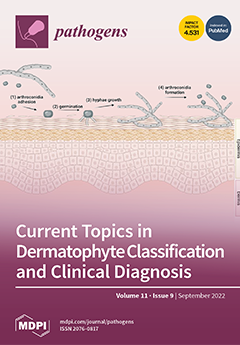Ascaris suum is present in traditionally managed indoor pig herds and in industrialized farms, especially in older fatteners and sows. The increasing resistance to common antihelminthic drugs redirected research towards alternative and traditional therapies, which also include medicinal plants. This study comparatively evaluated
[...] Read more.
Ascaris suum is present in traditionally managed indoor pig herds and in industrialized farms, especially in older fatteners and sows. The increasing resistance to common antihelminthic drugs redirected research towards alternative and traditional therapies, which also include medicinal plants. This study comparatively evaluated the in vitro antiparasitic effects of
Allium sativum L.,
Artemisia absinthium L.,
Cucurbita pepo L.,
Coriandrum sativum L.,
Satureja hortensis L. and
Calendula officinalis L. against
A. suum egg hatching and larval development.
A. suum eggs were sampled from randomized fecal specimens collected from traditionally raised swine. The egg suspension (ES, 12 × 10
3/mL) was divided into two controls (C) (1C—1 mL ES + 1 mL distilled water, 2C—five plates of 1 mL ES + 1 mL ethanol of 70%, 35%, 17.5%, 8.75%, and 4.375%, respectively) and six experimental groups, and placed in 3 mL cell plates. The experimental groups (EG, 1–6) included ES + each alcoholic plant extract (10%, 5%, 2.5%, 1.25%, 0.625%). Both C and EG were performed in quintuplicate. All variants were incubated at 27 °C for a total of 21 days.
A. suum eggs were examined after 2, 14 (L1), and 21 (L2/L3) days of incubation. The efficacy of all tested plant extracts increased with concentration. Anti-embryogenic effects on
A. suum eggs were expressed by all plants. A superior influence was observed in
A. sativum L.,
A. absinthium L.,
C. pepo L. and
S. hortensis L. extracts, at all concentrations tested.
A. sativum L. and
A. absinthium L. extracts showed the strongest antihelminthic activity, while
C. sativum L. and
C. officinalis L. were the weakest ascaricids. Future in-depth phytochemical studies are required to identify the compounds responsible for the anthelminthic properties of these plant species.
Full article






